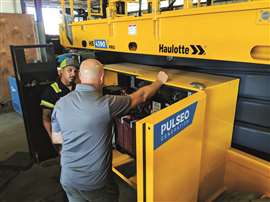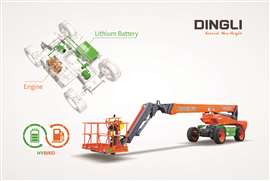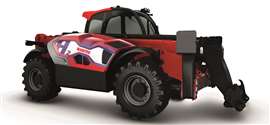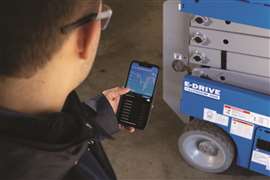Green energy for access - where is it heading?
30 October 2023
Access equipment has been going through a significant transformation in environmentally-friendly equipment. AI explores the theme
Access equipment has been going through a significant transformation in environmentally friendly equipment, but what is the long term direction? AI explores the theme.
It wasn’t long ago that diesel engine-powered access equipment was the main stay of the access industry, besides slab scissors of course, which have been battery driven since their inception. Previous to that, the only niche that offered bi-energy products was spider lifts.
Now, of course, all that has changed. There are many electric-powered RT MEWPS on the market and they are seeing varying degrees of adoption depending on the markets. In China, some 90% of rough terrain MEWPs sold are now electric-powered.
Charging challenges
 Haullote is now offering a transferable range extender on its Pulseo scissor range.
Haullote is now offering a transferable range extender on its Pulseo scissor range.
Other regions have a slower adoption rate. Looking at Europe the rate varies, with a greater emphasis on the northern countries in Scandinavia and a lower take up in the countries to the south. The issue is the well documented lack of charging infrastructure, which means many manufacturers are introducing range extenders to their RT MEWP models. For example, Haulotte has offered a diesel engine range extender option for its electric Pulseo RT scissors since their launch, which.
That range extender is now being adapted to be a removable item that can be swapped between machines in the all-electric Pulseo range. This means an operator can invest in one range extender and use it across multiple machines, as required.
This is just one of the solutions being devised to solve the issue of using 100% electric equipment when there are no charging facilities in the immediate area.
 Dingli’s answer to the shortage of charging infrastructure is the Range Extended series.
Dingli’s answer to the shortage of charging infrastructure is the Range Extended series.
Last year, Dingli introduced the Range Extended Series designed for that very reason. It is an advanced version of Dingli’s lithium battery-powered boom lift with a ‘mobile charger’, in the form of a small combustion engine. The series is based on the same specifications as the existing electric boom range, with maximum working heights of 22m to 34m.
Combined with a tank of fuel, the range extender, which charges the lithium batteries, ensures the machine can be used for up to 30 days on site.
These are just two examples, but the trend is clear towards electric equipment and the desire is there to try and make it happen.
Hydrogen solution?
Yet, the difficulties of recycling and ultimately procuring lithium batteries may set them back in the future. Manufacturers are weighing up alternative options and one of those is the hydrogen fuel cell.
Haulotte has presented an all terrain scissor lift equipped with a prototype of the hydrogen fuel cell it has developed through its partnership with engineering specialist Bouygues Energies & Services.
The HS 18 E Pro scissor lift, from the Pulseo range, was first on show at the Hyvolution trade fair in Paris this year.
Stéphane Hubert, CSO of Haulotte Group, said, “Exhibiting an aerial platform at a trade fair dedicated to hydrogen was an opportunity that had to be seized.”
“We are delighted with this partnership, which will enable us to continue the deployment of the Pulseo range, which is progressively renewing all internal combustion engine models with electric architectures.”
Over the course of this year, Bouygues Energies & Services will be testing a fuel cell-equipped aerial platform in real-life conditions on works sites.
Haulotte said while it will test this technology extensively, it will only be adopted if the technology proves to be an efficient option in the real workplace.
The Haulotte scissor follows Niftylift’s first foray into hydrogen power with the HR15H2E Narrow articulated boom - the innovative product represents a significant step forward with its hydrogen fuel cell for power.
Unlike conventional machines that rely on fossil fuels, the HR15H2E provides numerous advantages that can help businesses become more efficient, cost-effective, and environmentally friendly, says the company. Offering a working height of 15.7m with an outreach of 9.4m, the unit has a turret rotation of 355 degrees non-continuous and a cage rotation of 180 degrees.
Telehandler focus
Manitou has also made significant moves in this direction, with the announcement that it will release a prototype hydrogen fuel cell powered telehandler later this year.
However, the jury is still out as to whether hydrogen will work for aerial platforms, at least in the near term.
 Manitou is embracing the hydrogen fuel cell for telehandlers.
Manitou is embracing the hydrogen fuel cell for telehandlers.
Fanny Sourisseau, Manitou global marketing product Manager for MEWP, says, “My view is that you have to find the right technology for the right application. What we’ve observed is that aerial work platforms fit very well to electric power.
“As for hydrogen, it’s not out of the question that it could be used for MEWPs in the future. We’ve already developed a prototype for telehandlers. But as a manufacturer, our role is to find the most appropriate technology for each machine and its application.”
Dinolift is certain of the future of hybrid and electric MEWPs.
Karin Nars, managing director of Dinolift, comments, “Everyone’s been looking in this area, with the Covid period accelerating the transition. From the outset, we chose to go 100% electric on our internal combustion products, without compromising on the performance of our machines.
“The biggest market for electric aerial work platforms remains Europe, and Northern Europe in particular.” Nars adds, “We see that the demand for hybrid and electric products is constantly rising, and we embrace that trend.”
The main stumbling block will be the current economic pressures, adds Nars, because companies are even more cost-conscious than before, with electric options tending to be more expensive than diesel.
“Investments are considered very thoroughly and still the electric versions tend to be more expensive than the ones running with the combustion engine.”
The next challenge will be to educate the market as to the benefits of an electric RT model in the long term. “Of course, lifetime costs are significantly lower with the electric machines and also the green values are more and more important in many companies’ strategies.
“We think that the demand for these machines is increasing in all our main markets, so providing top quality electric and hybrid machines is of the utmost importance for us in the future.”
Complementary options
So, where will all this lead? The development of electric equipment may well go hand in hand with other industry dynamics like the lack of availablity of skilled labour and the need for autonomous technology.
 Genie’s E-Series range
Genie’s E-Series range
Combined, we could see a rise in the likes of robotics. As Genie points out, “An emerging technology that will likely gain momentum is robotics, and particularly robotics that support safe, productive human work — especially when you consider the cost and scarcity of labour in some markets.”
Earlier this year, its parent company Terex Corporation made an investment in Apptronik, a company specialising in the development of versatile, mobile robotic systems.
Separate from the equity investment, Terex and Apptronik have entered into a co-development agreement to work together to create potential robotic applications for Terex products.
More generally the company concludes, “We’re not ready to talk specifically about what we have coming, but we can say we have several new products in development right now. In general, electrification is the main trend. We are looking to extend electrification options across our boom lineup, with the goal of delivering MEWPs with the performance and quality our customers and operators expect from Genie, along with a lower cost of ownership.”
STAY CONNECTED




Receive the information you need when you need it through our world-leading magazines, newsletters and daily briefings.
POWER SOURCING GUIDE
The trusted reference and buyer’s guide for 83 years
The original “desktop search engine,” guiding nearly 10,000 users in more than 90 countries it is the primary reference for specifications and details on all the components that go into engine systems.
Visit Now
CONNECT WITH THE TEAM










